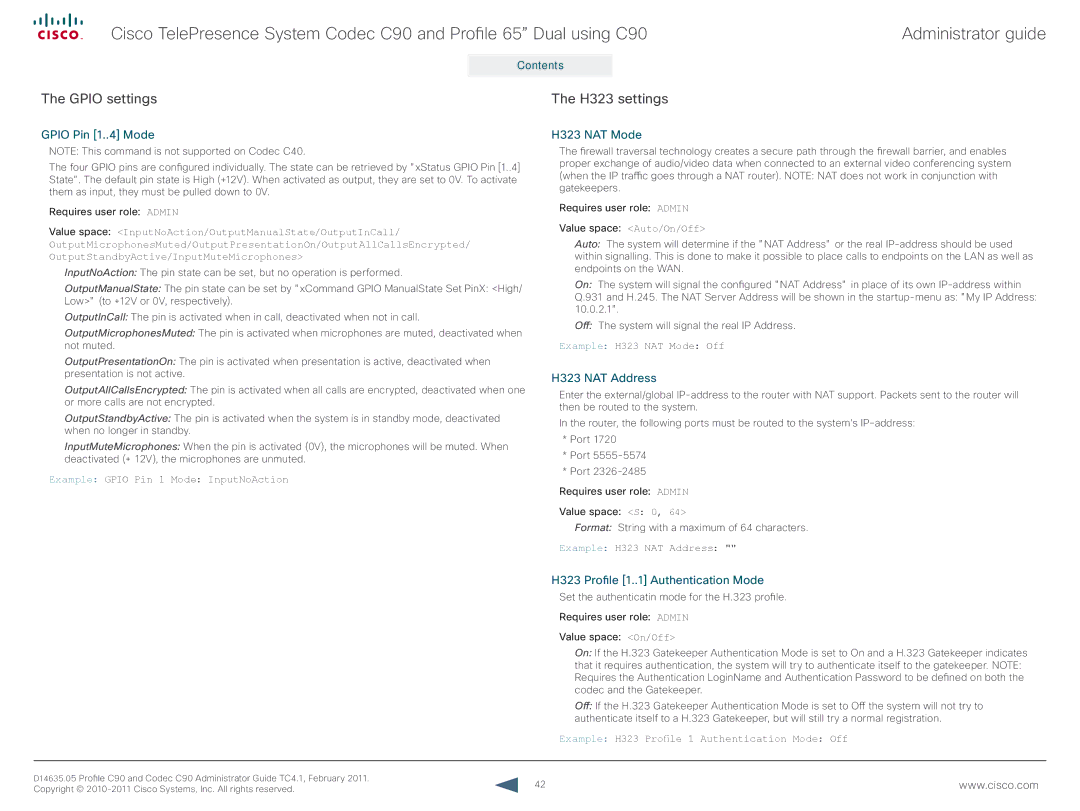
Cisco TelePresence System Codec C90 and Profile 65” Dual using C90
Contents | Introduction | Web interface | Advanced configuration | Password protection | Appendices |
Administrator guide
Contact us
The GPIO settings
GPIO Pin [1..4] Mode
NOTE: This command is not supported on Codec C40.
The four GPIO pins are configured individually. The state can be retrieved by "xStatus GPIO Pin [1..4] State". The default pin state is High (+12V). When activated as output, they are set to 0V. To activate them as input, they must be pulled down to 0V.
Requires user role: ADMIN
Value space: <InputNoAction/OutputManualState/OutputInCall/ OutputMicrophonesMuted/OutputPresentationOn/OutputAllCallsEncrypted/ OutputStandbyActive/InputMuteMicrophones>
InputNoAction: The pin state can be set, but no operation is performed.
OutputManualState: The pin state can be set by "xCommand GPIO ManualState Set PinX: <High/ Low>" (to +12V or 0V, respectively).
OutputInCall: The pin is activated when in call, deactivated when not in call.
OutputMicrophonesMuted: The pin is activated when microphones are muted, deactivated when not muted.
OutputPresentationOn: The pin is activated when presentation is active, deactivated when presentation is not active.
OutputAllCallsEncrypted: The pin is activated when all calls are encrypted, deactivated when one or more calls are not encrypted.
OutputStandbyActive: The pin is activated when the system is in standby mode, deactivated when no longer in standby.
InputMuteMicrophones: When the pin is activated (0V), the microphones will be muted. When deactivated (+ 12V), the microphones are unmuted.
Example: GPIO Pin 1 Mode: InputNoAction
The H323 settings
H323 NAT Mode
The firewall traversal technology creates a secure path through the firewall barrier, and enables proper exchange of audio/video data when connected to an external video conferencing system (when the IP traffic goes through a NAT router). NOTE: NAT does not work in conjunction with gatekeepers.
Requires user role: ADMIN
Value space: <Auto/On/Off>
Auto: The system will determine if the "NAT Address" or the real
On: The system will signal the configured "NAT Address" in place of its own
Q.931 and H.245. The NAT Server Address will be shown in the
Off: The system will signal the real IP Address.
Example: H323 NAT Mode: Off
H323 NAT Address
Enter the external/global
In the router, the following ports must be routed to the system's
*Port 1720
*Port
*Port
Requires user role: ADMIN
Value space: <S: 0, 64>
Format: String with a maximum of 64 characters.
Example: H323 NAT Address: ""
H323 Profile [1..1] Authentication Mode
Set the authenticatin mode for the H.323 profile.
Requires user role: ADMIN
Value space: <On/Off>
On: If the H.323 Gatekeeper Authentication Mode is set to On and a H.323 Gatekeeper indicates that it requires authentication, the system will try to authenticate itself to the gatekeeper. NOTE: Requires the Authentication LoginName and Authentication Password to be defined on both the codec and the Gatekeeper.
Off:If the H.323 Gatekeeper Authentication Mode is set to Off the system will not try to authenticate itself to a H.323 Gatekeeper, but will still try a normal registration.
Example: H323 Profile 1 Authentication Mode: Off
D14635.05 Profile C90 and Codec C90 Administrator Guide TC4.1, February 2011. | 42 | www.cisco.com |
Copyright © |
